Blog
CATEGORY: Best practiceemail-marketing
10 Questions every email marketer has asked at least once…
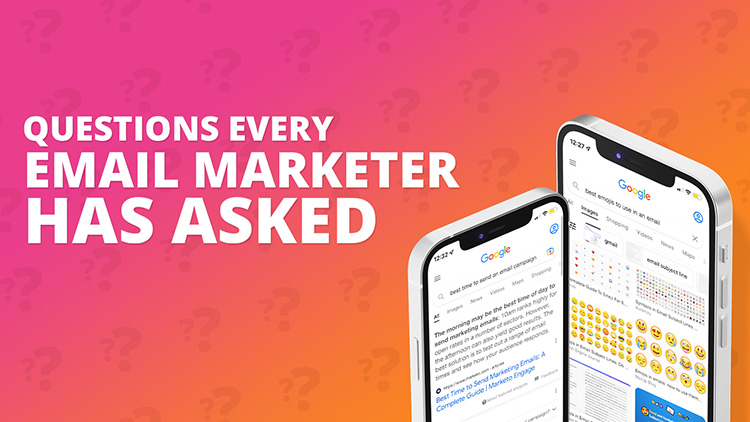
There are a number of questions that every email marketer has asked themselves at one stage or another - and although the questions sound easy the answers are invariably more complex.
Q: When is the best time to send my email campaigns?
This is one of the most frequently asked questions and one of the most debated. Ask 10 people, and you’ll get 10 different answers. Even some of my most trusted sources have differing opinions on the topic based on their data sets:
Kissmetrics says early mornings and weekends … but also says those days/times are also the most likely to get you unsubscribes and bounces
Experian’s benchmark study says that 8 pm to midnight is optimal
Wordstream thinks that Thursday from 8-9 am is best
Many other ESPs concluded that Tuesdays and Thursdays are the surefire winners, with Sunday afternoon coming top for senior level contacts and workaholics.
There are also lots of interesting examples out there to help your thought process; ie retailers often see the best results at the beginning of the month (after payday), whether the open is on mobile or desktop can affect timings and kissmetrics have even created the below consumer focus breakdown of the day.
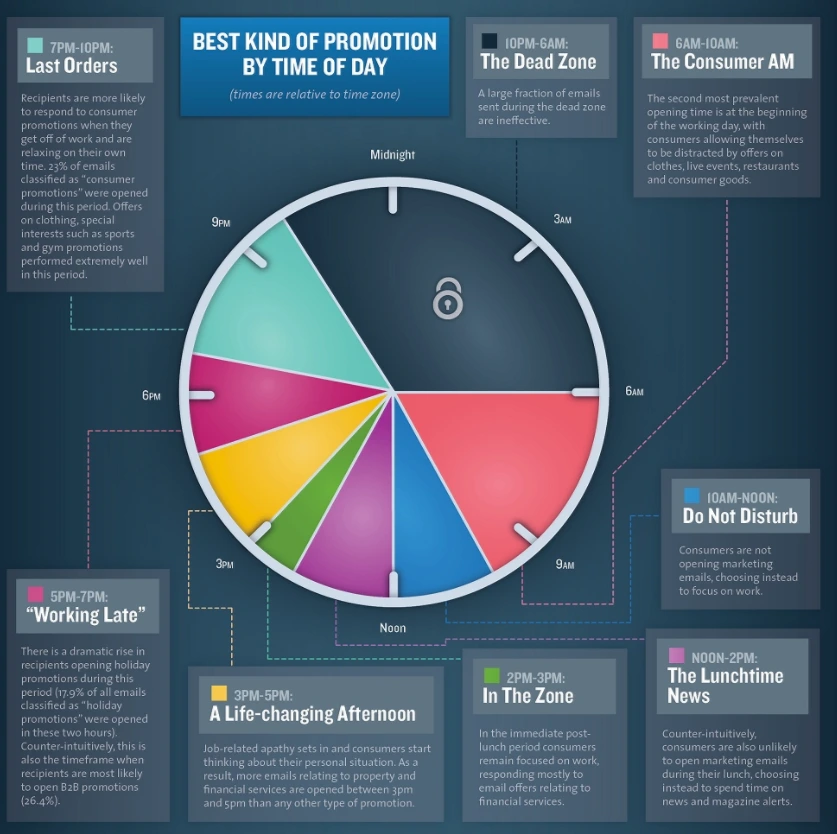
However, a great quote to bear in mind is from a guy named DJ Waldow:
“Here’s the deal. Your audience is not my audience. You have to test to find the optimal day and time for YOUR audience.”
The key takeaway here: Consider your audience first.
That said, something that should not be ignored at this point, is that the best time to send a message is when your recipient is looking for it, even dare I say, waiting for it. This is why triggered emails are so important to include in your email armoury. Triggered emails have a significantly higher engagement rate, regardless of industry, because they arrive in your contacts inbox when they are expecting it or at the very least primed to engage with you. So if you don’t have a welcome campaign, registration follow up, abandon transaction campaign or similar within your email strategy – now is the time!!
Read more about email automation
Q: How often should I send email campaigns?
Yet another questions where there is no right or wrong answer. To find what is effective for your company, vary the quantity of emails sent out month to month, and take note of what number or distribution pattern sees the highest open rate and conversion.
Your email marketing frequency should be based on your typical customers' purchase cycle and profile. If customers typically make repeat purchases every six months, don’t inundate them with targeted email advertising right after they’ve made a purchase, unless that correspondence is about a complementary product.
Think about ALL the email your subscribers may be receiving from your organisation when adjusting your email frequency. Targeted email advertising is just one channel, put this in context with blog updates, messages from account managers, surveys and event comms to ensure that you don’t overwhelm your subscribers.
Finally, make sure your subscribers know from the outset what they are signing up for. If you send daily emails, tell them they are signing up for DAILY emails. Marketing Sherpa found that while over 80% of consumers expect monthly emails, less than 20% want daily emails. Too much email is the number one reason people unsubscribe.
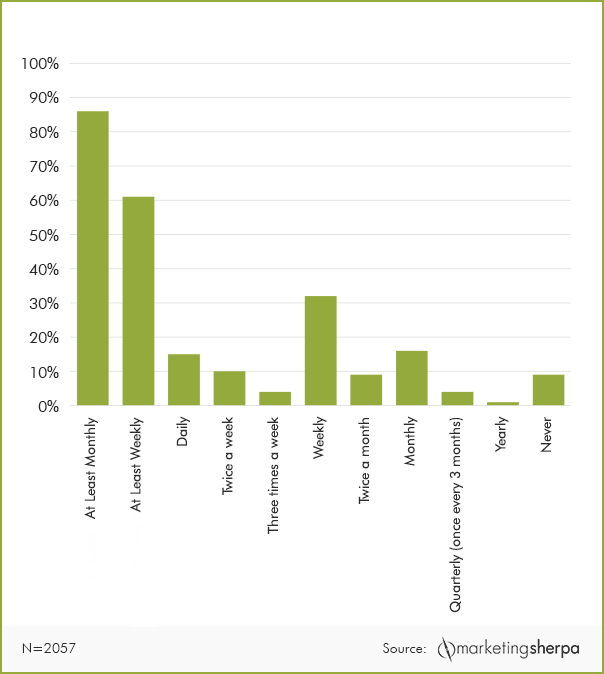
Test, test and test again.
Q: How can I get more contacts to open my emails?
There are only two things that affect someone’s decision to open an email:
Who it’s from
What it’s about
That said, those two things encompass a vast array of possibilities.
So for 1. Find the best from name for the audience – should all your emails have the same from name? Do you get better results if you include your company name as well as a person’s name? Do you send it from their account manager or another key person in your organisation? Do you have one type of information coming from one person and another from a different person? Do you use a dynamic from name?
In our experience we have found that a named person, ideally one that is recognisable, works best. Emails to our customers are sent from our Customer Services Manager, offers and events from our Customer Success Consultant and emails to prospects include both our sales manager's name and the e-shot brand name.
How do you find out? Test, test and test again.
For 2, of course the focus is on the subject line. This is a topic much discussed in email marketing circles as it is such a critical consideration. Indeed we have a number of articles that are well worth a read. But in short, wherever you can, test your subject lines and run with the most successful. (And if your list is too small for a viable test - create a hypothesis and test across a number of sends.)
There are a number of things to experiment with, to see which resonates best with your audience but from our experience elements to be considered include:
Benefit led (clear and direct) or intriguing (sparking curiosity)
Questions
Use of emojis (where appropriate)
The best email subject lines are short and compelling. Set expectations up front and let the email content do the rest. And don’t forget about the preview text – as this gives you valuable real-estate to drive home your message, so don’t waste it!
And speaking of subject lines.....
Q: How long should my subject line be?
You have only 3-4 seconds before someone decides whether or not they are going to open your email, so it’s important to make an impact. 50 characters (or fewer) is the general rule of thumb for subject line length.
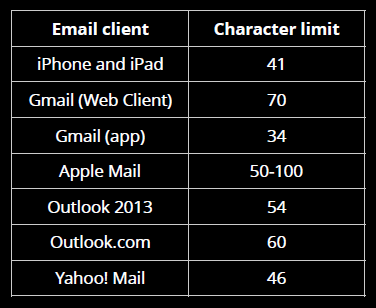
Recent iOS updates have given the subject line more prominence and space in the full email view.
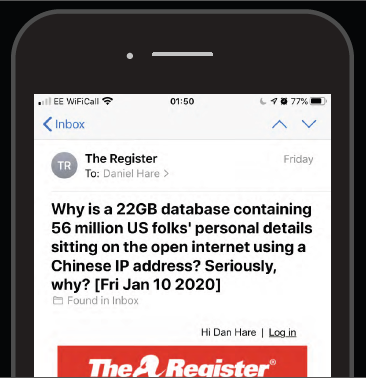
But is there a correlation between the length of the subject line and engagement post open?
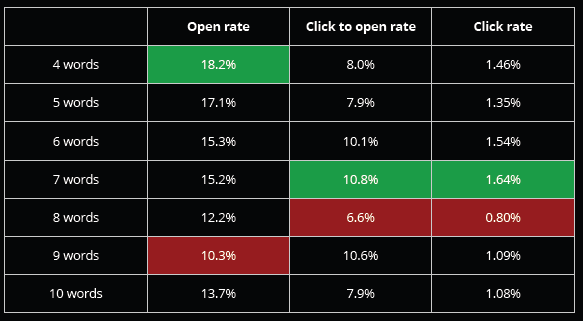
Don’t forget about the preview text:
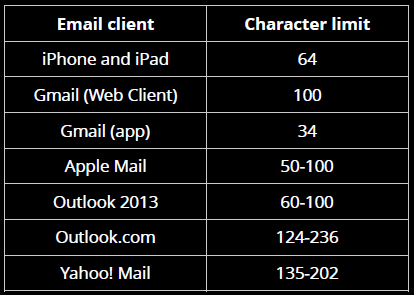
Q: What is a good open rate?
Similar to the best day/time to send an email, this question also has the mainstay answer of “it depends”. Even if two people in the same industry sent the same email at the same time with the same content, they could have very different open rates due to factors like list quality and personal relationship. So sadly again, there’s no definite answer to this question.
If you are looking for a benchmark, then one place to start is with a comparison to your industry – take a look at this chart from hubspot as a starting point.
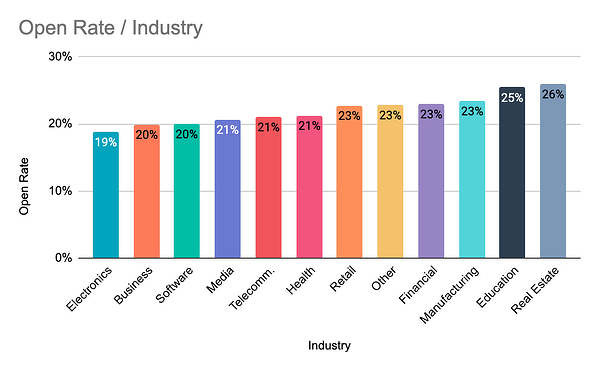
However, this is just one piece of a larger puzzle, and what
people do after opening your email is what really matters, so here are industry clickthough rates to benchmark against too.
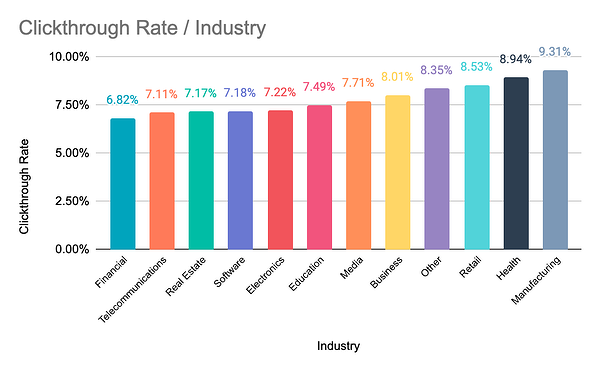
Q: How do I stop my messages going into junk?
There are three elements that impact your deliverability (and your deliverability determines whether your mail arrives in an inbox or junk or indeed if it is delivered at all):
Data
Content
Reputation
Data: By sending your messages to an engaged, opted-in list you are a giant step closer to good deliverability. Maintaining your list health is key as data degrades over time. Have a read of our dedicated article on list management.
Content:As marketers, this is the part of the email journey that we dedicate the most time and attention to. Crafting our subject lines, agonising over our text and calls to action, aiming to create a beautiful engaging email that our recipients will love. Avoiding overtly salesy language and spammy content with crazed punctuation or all CAPS we all recognise as best practice, find out more from our 10 Don'ts and Dos
The best way to really see how well your email would perform and the words and phrases that help or hinder the inbox position is to use a forensic tool – like e-shot forensics when you can look in detail of the specifics of the mail you are about to send.
Reputation: An email sender reputation is a score that an Internet Service Provider (ISP) assigns to an organisation that sends email. It’s a crucial component of your email deliverability. The higher the score the more likely an ISP will deliver your mails. If the score falls below a certain level, the ISP may send messages to recipients’ spam folders or even reject them completely. Take a look at “When reputation is everything”
Your deliverability is also affected by the behaviours of your message recipients
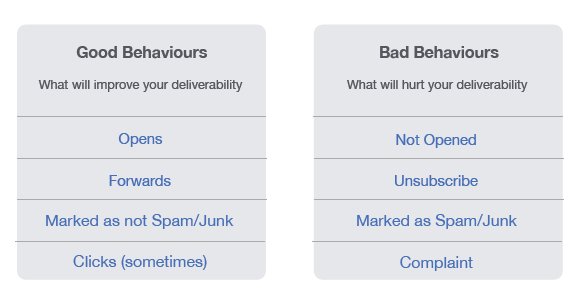
The other thing that you can do is to ask your recipients to add your email address to an allowlist (formerly known as whitelist).
As deliverabilityis such a huge topic we have a number of resources available to help you, including a deliverability webinar you can watch.
Q: What is the difference between a hard bounce and a soft bounce?
In short, a hard bounce is permanent and a soft bounce is temporary but for a more detailed explanation, take a look at our dedicated article.
Q: How do I know if I am blacklisted and what can I do?
The likelihood is most email marketers have had campaigns blocked or blacklisted at some point, but they may not be aware of them.
Prevention is better than cure, but if something does slip through or a blacklisting occurs because of issues with the contacts the campaign is sent to, remedial action can also be carried out post-campaign. This will typically involve submitting an unblock request to the relevant blacklist service. This varies in complexity, but the e-shot team can guide you accordingly.
e-shot monitors and provides real-time reporting to clients on 96 important blacklists. The highly technical nature of this technology means that it is difficult to monitor manually. That’s why we recommend checking your campaign throughout the creation process and again, just before sending by using Email Forensics.
Want to know more – take a look at our blacklisting article
Q: How do I make sure my emails will all look great when delivered?
Make sure that all your mails are mobile optimised and use a tool like our Email Forensics to see how your message will render in all the various email clients. Email clients handle email creatives in such a variety of ways that using a tool to review across the main clients
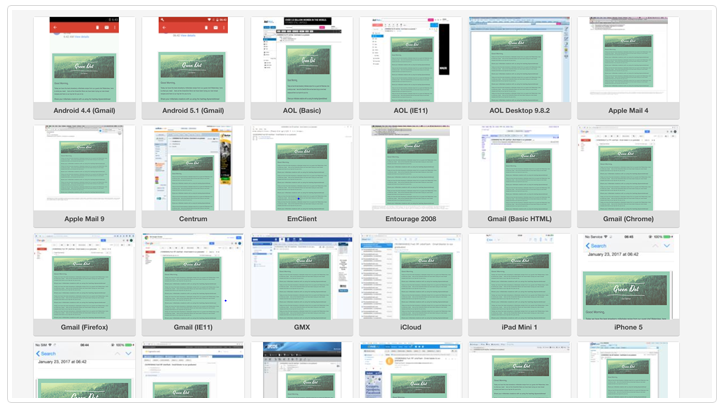
Also, due to its growing popularity, consider that some of your contacts will be using “dark mode” and ensure that your images and colour contrasts will work on both standard and dark renderings. See more on dark mode here.
Q: What are the key principles to make sure that emails are accessible?
Here are a few of the main points – but for a more detailed guide download our accessibility checklist.
Technical
Use responsive templates so that your emails are compatible on all devices, screen sizes and mail clients
Always use alt text and HTML tags for images/buttons/headers etc. This helps people using screen readers
Design
Include a text only version of your email
Keep the font size above 14 pixels and avoid thin fonts
Be mindful of colours, ensure text contrasts against background colours
Use your email hierarchy so there is a clear flow of information
Make your links large & easy to click
These are the questions that most email marketers have asked at one stage or another - but what questions should we be asking to really drive engagement and boost sales - here is what we think are the 10 questions email marketers should be asking.
If you have a question not covered here, why not join us for our webinar "Ask the B2B email marketing experts" and pose your question directly to us.
Solutions
Email marketing healthcheck
We are confident that we can help you, which is why we offer a free healthcheck to identify potential issues with your current programme and free advice on things that could be done to improve it.